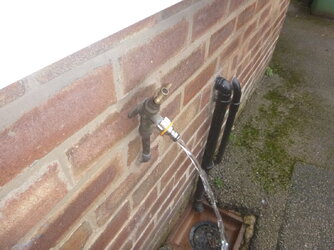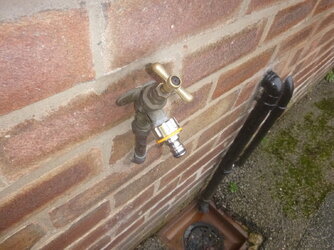Fastpedaller
Über Member
Plumber here. Having only looked at the first page before writing the above note, I've seen all the confusion above. I'm 99% certain you have a 1/2" BSP thread on the end of that tap, so easily obtainable parts! There are 3/4"BSP taps available and I've sourced them for farms around where I live. The 3/4" taps aren't easy to source, and look a lot bigger. BTW the advice above about fitting a new tap is correct for the type of tap you have, which I think you won't find for sale any more. Let me explain.
Usual setup....
1. A 15mm supply pipe
2. A wall=plate elbow screwed to the wall
3. The tap is then screwed into the wall plate elbow, whilst 'supporting' the wall plate elbow with another adjustable spanner to ensure the fittings in the wall and the supply pipe aren't strained. No olive is required.
4. Before screwing the tap in place wrap LOTS of ptfe tape around the thread (so much the thread is barely visible).... that ensures it is both watertight and you can stop turning when the tap is vertical. It seems a bodge, but is the only way because the threads are somewhat loose and of course 'end up where they end up' and you don't want a tap pointing sideways.
BTW your tap is quite old and of a design not generally used any more (I'm sure someone will find one somewhere and tell me I'm wrong ) as it is a combined wall plate and tap. Of interest is the small screw on the bottom which was intended to be removed to drain down to avoid freezing - on your setup that wouldn't work because the supply pipe would still have water in it ready to freeze!
) as it is a combined wall plate and tap. Of interest is the small screw on the bottom which was intended to be removed to drain down to avoid freezing - on your setup that wouldn't work because the supply pipe would still have water in it ready to freeze!
If you examine taps sold today there is a flat on the underside where this screw would have been, so the same 'moulds' are being used in the production process
Usual setup....
1. A 15mm supply pipe
2. A wall=plate elbow screwed to the wall
3. The tap is then screwed into the wall plate elbow, whilst 'supporting' the wall plate elbow with another adjustable spanner to ensure the fittings in the wall and the supply pipe aren't strained. No olive is required.
4. Before screwing the tap in place wrap LOTS of ptfe tape around the thread (so much the thread is barely visible).... that ensures it is both watertight and you can stop turning when the tap is vertical. It seems a bodge, but is the only way because the threads are somewhat loose and of course 'end up where they end up' and you don't want a tap pointing sideways.
BTW your tap is quite old and of a design not generally used any more (I'm sure someone will find one somewhere and tell me I'm wrong
 ) as it is a combined wall plate and tap. Of interest is the small screw on the bottom which was intended to be removed to drain down to avoid freezing - on your setup that wouldn't work because the supply pipe would still have water in it ready to freeze!
) as it is a combined wall plate and tap. Of interest is the small screw on the bottom which was intended to be removed to drain down to avoid freezing - on your setup that wouldn't work because the supply pipe would still have water in it ready to freeze!If you examine taps sold today there is a flat on the underside where this screw would have been, so the same 'moulds' are being used in the production process



